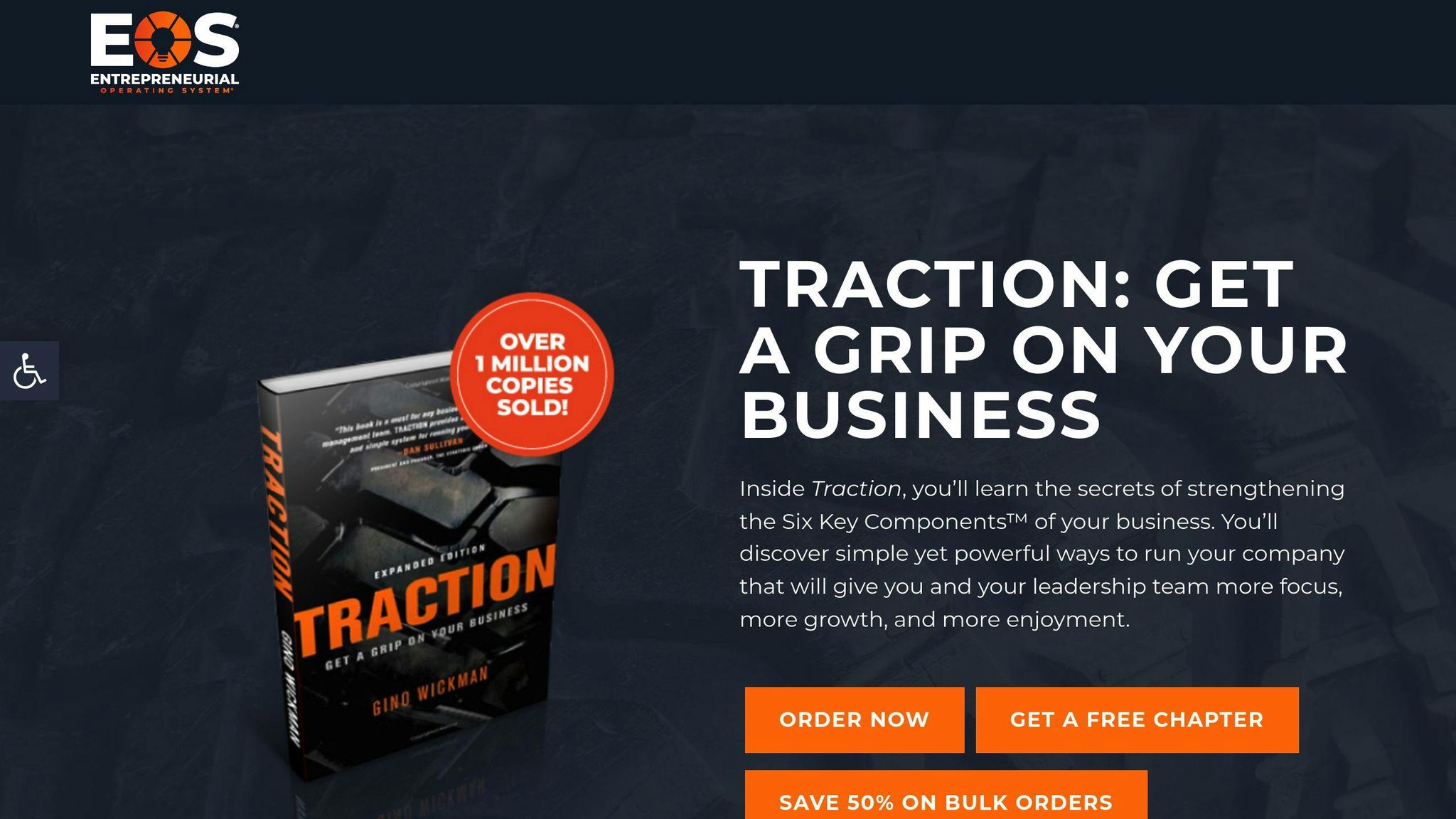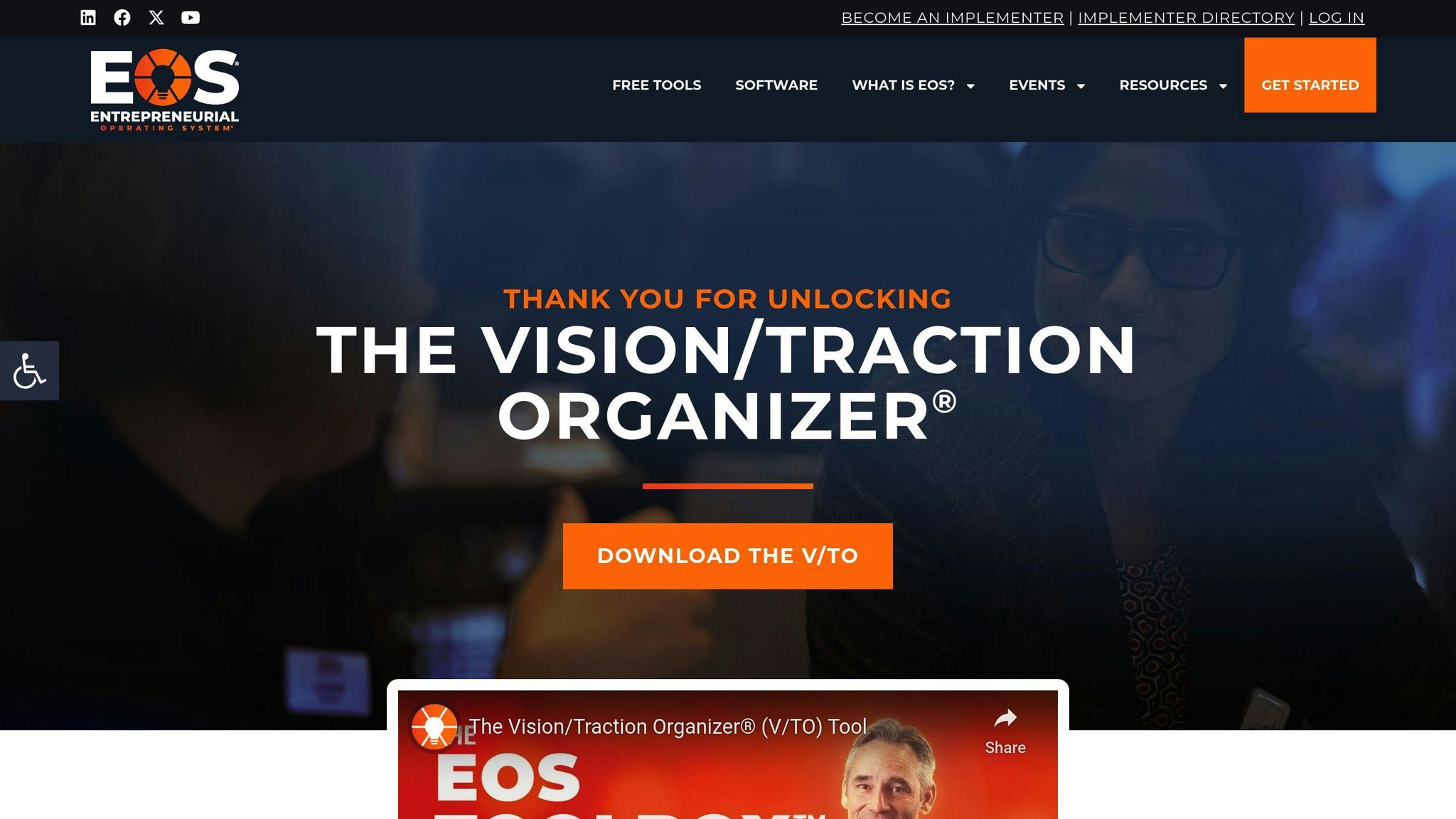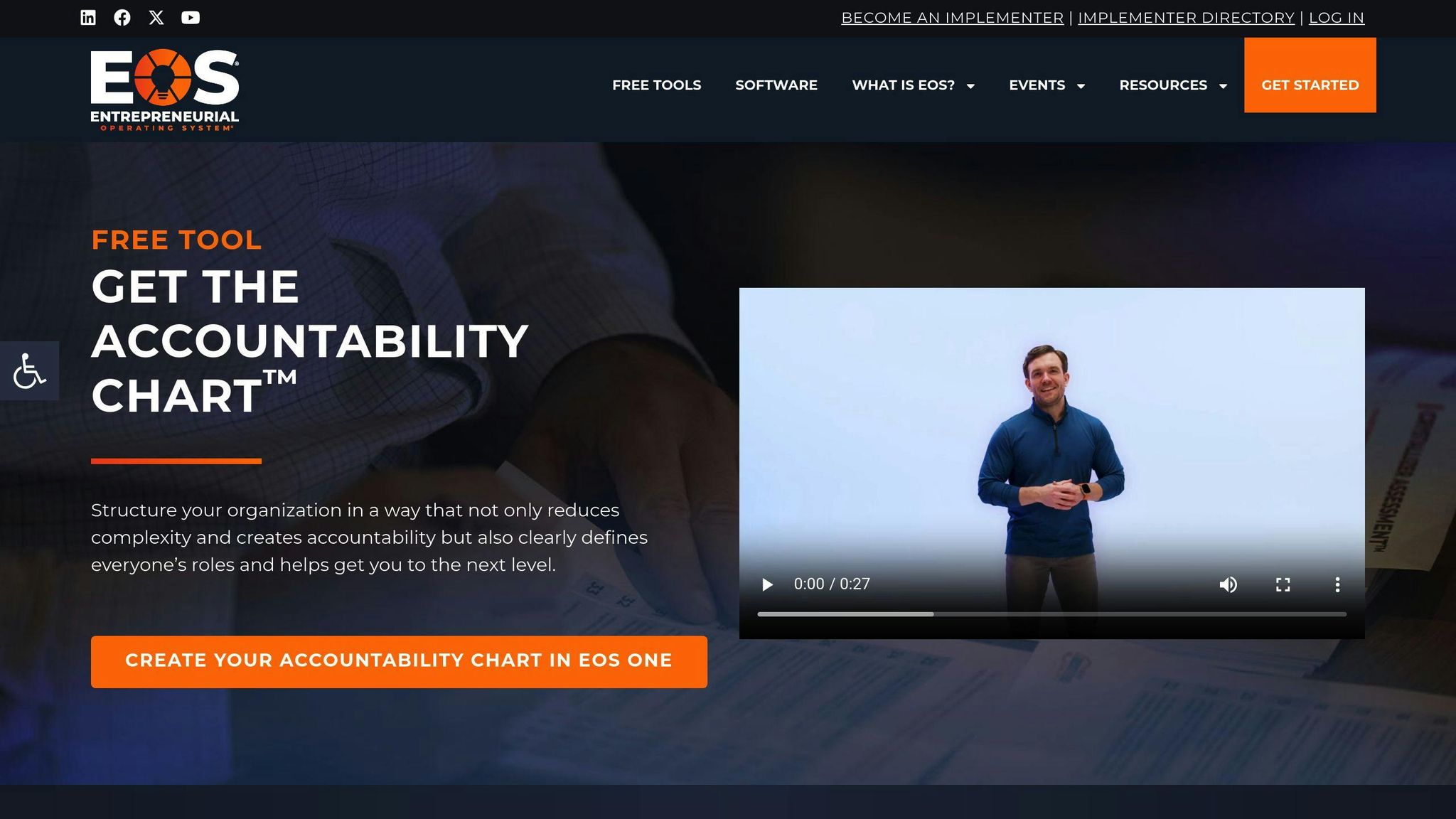Level Up Your Nonprofit with EOS: Simple Tools for Big Impact
Discover how the Entrepreneurial Operating System (EOS) can transform nonprofit organizations by enhancing clarity, teamwork, and impact.

EOS (Entrepreneurial Operating System) isn't just for businesses - it's a game-changer for nonprofits too. Here's why you should care:
- Clarify your mission and goals
- Improve teamwork and accountability
- Solve problems faster
- Track progress effectively
EOS helps nonprofits do more with less. It's about working smarter, not harder.
Key EOS tools for nonprofits:
- Vision/Traction Organizer (V/TO)
- Accountability Chart
- Scorecard
- Level 10 Meetings
- 90-day goals ("Rocks")
- Issue Solving Track
| EOS Component | What It Does |
|---|---|
| Vision | Sets clear goals |
| People | Puts right people in right roles |
| Data | Guides smart decisions |
| Issues | Solves problems quickly |
| Process | Creates consistency |
| Traction | Drives action steps |
Is EOS right for you? Ask yourself:
- Struggle to reach big goals?
- Team not on the same page?
- Want to boost impact without burnout?
If you nodded, EOS might be your answer. It's not magic, but it works. Just ask the 100,000+ organizations already using it.
Ready to start? Read "Traction", get your team on board, and focus on your biggest issues first. EOS can help you change more lives, faster.
Related video from YouTube
The 6 main parts of EOS

EOS helps nonprofits run better by focusing on six key areas:
1. Vision
A clear vision guides your nonprofit. It includes:
- Core values
- Core focus
- 10-year target
- Marketing strategy
Example: A food bank's 10-year target might be "End hunger in our city by 2033."
2. People
EOS wants "the right people in the right seats." This means:
- Hire based on values
- Use an Accountability Chart
- Define roles clearly
3. Data
Numbers help nonprofits make smart choices. EOS suggests:
- Create a Scorecard (5-15 key metrics)
- Update weekly
- Use data to spot trends
Example Scorecard for a youth mentoring program:
| Metric | Weekly Goal |
|---|---|
| New mentors | 5 |
| Mentor-mentee matches | 10 |
| Fundraising dollars | $5,000 |
4. Issues
EOS has a system for solving problems:
- List issues
- Discuss important ones
- Solve them for good
5. Process
Document core processes for consistency:
- Volunteer onboarding
- Donor management
- Program delivery
6. Traction

Traction is about getting things done:
- Set 90-day goals ("Rocks")
- Have productive weekly meetings
- Create clear to-do lists
"When your nonprofit runs on EOS, everyone is rowing in the same direction." - EOS Implementer
How to start using EOS
Is EOS right for your nonprofit? Ask yourself:
- Can't reach your big goals?
- Overworked but not making enough impact?
- Team not on the same page?
- Hit a growth ceiling?
If you nodded, EOS might be your answer.
Getting started
1. Learn EOS basics
Read "Traction: Get a Grip on Your Business". Consider an EOS coach.
2. Book a 90-Minute Meeting
Chat with an EOS Implementer for free. They'll tell you if EOS fits your nonprofit.
3. Have a Focus Day
In 6-8 hours, you'll learn key EOS tools:
| Tool | What it does |
|---|---|
| Accountability Chart | Who does what |
| Rocks | 90-day goals |
| Meeting Pulse | Regular check-ins |
| Scorecard | Track what matters |
4. Build your Vision
Two days to nail down your:
- Core values
- Core focus
- Long-term goals
5. Start small, grow big
Begin with the basics. Add more as your team gets it.
Tackling common issues
- Team resists change? Show them the wins. The Phoenix Society for Burn Survivors used EOS to aim for "One Million Strong."
- Lack discipline? Schedule must-attend planning and "Level 10" meetings.
- Wrong roles? Use the Accountability Chart to put the right people in the right seats.
- Too much data? Pick 5-15 key metrics for your Scorecard. Update weekly to spot trends.
EOS tools for nonprofits
EOS offers tools to help nonprofits run better. Here are the main ones:
Vision/Traction Organizer (V/TO)

The V/TO is a two-page plan. It includes:
- 10-Year Target
- 3-Year Picture
- 1-Year Plan
- Issues List
It keeps everyone aligned on goals and progress.
Accountability Chart

This chart shows who does what. It:
- Clears up role confusion
- Covers all key jobs
- Shows how roles work together
90-day goals
These are short-term priorities. Here's how they work:
- Set 1-7 main goals for 3 months
- Align with bigger plans
- Check weekly
Level 10 Meetings

These are weekly 90-minute meetings. They help teams solve problems and stay aligned:
| Time | Activity |
|---|---|
| 5 min | Good news |
| 5 min | Key numbers |
| 5 min | 90-day goals check |
| 5 min | Customer/employee updates |
| 5 min | To-do list |
| 60 min | Solve main issues |
| 5 min | Wrap up and rate |
Issue Solving Track
This method fixes problems fast. Three steps:
- Identify the real issue
- Discuss solutions
- Decide next steps
Fitting EOS to nonprofit needs
Nonprofits can use EOS to boost their impact. Here's how:
EOS and your nonprofit's mission
The Vision/Traction Organizer (V/TO) helps nonprofits focus:
- Spell out goals clearly
- Ensure everyone knows the mission
- Check progress often
Mark O'Donnell, an EOS expert for nonprofits, says:
"EOS is not a rigid framework demanding blind compliance but a logical and methodical one, and with the fundamentals understood can be adjusted to the unique needs of the organization."
EOS for fundraising
EOS can help nonprofits raise more money:
- Set clear fundraising goals
- Track progress with weekly scorecards
- Use Level 10 Meetings to solve issues fast
EOS and nonprofit boards
Boards work better with EOS:
| EOS Tool | How It Helps Boards |
|---|---|
| V/TO | Keeps focus on big picture |
| Accountability Chart | Shows who does what |
| Quarterly Meetings | Aligns board with leadership |
EOS Worldwide faced this challenge when they sold to a private equity firm. Their solution?
1. Quarterly Vision-Setting Meeting before board meetings
2. "Visionary V/TO Walk-Through Video" to prep board members
3. V/TO as the main guide for all board talks
EOS and nonprofit planning
EOS helps nonprofits plan long-term with a structured approach:
Setting long-term goals
The Vision/Traction Organizer (V/TO) sets clear, long-term goals:
- Define 3-year and 10-year targets
- Align goals with the mission
- Break big goals into smaller steps
Yearly planning meetings
Nonprofits hold a 2-day Annual Planning Meeting to:
1. Review the past year
Look at successes, failures, and goal achievement.
2. Plan for the future
Update the 3-year picture, create a 1-year plan, and set quarterly "Rocks" (priority goals).
3. Strengthen the team
Do team-building exercises and improve communication.
Quarterly progress checks
EOS recommends quarterly meetings to stay on track:
| Component | Purpose |
|---|---|
| Rock review | Check priority goal progress |
| Issue solving | Address key problems |
| Goal setting | Create new 90-day Rocks |
These meetings help nonprofits focus on long-term goals, adjust plans, and keep the team accountable.
"The quarterly meeting brings peace of mind to a founder as the organization gains Traction 90 days at a time." - Mike Schroeder, Founder of Roundstone Insurance
Measuring results with EOS
EOS helps nonprofits track their impact through a focused approach to measuring results. It's all about zeroing in on the metrics that really matter.
Choosing what to measure
With EOS, nonprofits pick 5-15 key numbers that show if they're moving in the right direction. These "Measurables" are:
- Based on activities
- Looking ahead, not behind
- Tied to specific roles
For instance, a nonprofit might track:
- New donors per week
- Monthly volunteer hours
- Quarterly grant submissions
Creating a nonprofit scorecard
The EOS Scorecard™ is where the magic happens. It's a simple tool that looks like this:
| What | Who | Goal | Week 1 | Week 2 | ... | Week 13 |
|---|---|---|---|---|---|---|
| New donors | Jane | 10 | 8 | 12 | ... | 11 |
| Volunteer hours | Tom | 100 | 95 | 105 | ... | 98 |
| Grants submitted | Sarah | 3 | 2 | 4 | ... | 3 |
Each team usually has its own Scorecard, focusing on what matters to them.
Using data to drive decisions
EOS isn't just about collecting numbers. It's about using them:
1. Weekly check-ins: Teams look at their numbers to spot issues early.
2. Problem-solving: When things are off-track, they use the IDS method:
- Identify the root cause
- Discuss solutions
- Solve by taking action
3. Planning ahead: Scorecard data helps shape quarterly and yearly plans, keeping goals realistic and strategies on point.
EOS and nonprofit leadership
EOS helps nonprofits build strong teams and plan ahead. Here's how it works:
Building a strong team
EOS focuses on creating a united leadership group:
- Pick the right people: Smart, productive, and friendly team members
- Set shared goals: Objectives that need teamwork
- Foster respect: Everyone values each other's input
Simone, who runs a homeless nonprofit, spent a year improving her team. She swapped out two members and worked on relationships. The result? Better teamwork and faster decisions.
Key leadership roles in EOS
EOS defines clear roles for nonprofit leaders:
| Role | Responsibility |
|---|---|
| Visionary | Sets big picture direction |
| Integrator | Turns vision into action |
| Finance | Manages money and budgets |
| Operations | Runs daily activities |
| Marketing | Handles outreach |
The executive director often takes on the Visionary or Integrator role. Sean Kosofsky from Mind the Gap Consulting says:
"The executive director was hired to get results. This means they have to make tough decisions, while also modeling good behavior."
Planning for future leaders
EOS helps nonprofits prepare for leadership changes by:
1. Creating clear job descriptions
This helps everyone understand each role.
2. Regular one-on-one meetings
These build trust and open communication.
3. Addressing issues quickly
Don't let problems fester - solve them fast.
4. Training and development
Prepare team members for future leadership roles.
Improving nonprofit work with EOS
EOS boosts nonprofit performance by zeroing in on three key areas:
Making work easier
EOS cuts through nonprofit complexity:
- The Accountability Chart ends role confusion
- Documented core processes boost efficiency
- The Issue Solving Track squashes problems fast
Glenn Mahnken, Former Head of Operations at Atomic Revenue, puts it this way:
"EOS challenges a management team, and each individual member of that team, to truly become their best by honestly and openly sharing observations and experiences."
Better team communication
EOS supercharges info sharing:
- Level 10 Meetings keep everyone in sync
- The Vision/Traction Organizer (V/TO) aligns goals
- Open, honest issue discussions become the norm
Increasing responsibility
EOS ensures everyone pulls their weight:
- 90-day goals set clear priorities
- The Scorecard tracks weekly metrics
- Team members own their roles and results
| EOS Tool | Purpose | Nonprofit Benefit |
|---|---|---|
| Accountability Chart | Define roles | Clear responsibilities |
| Level 10 Meetings | Weekly check-ins | Improved communication |
| Scorecard | Track key metrics | Data-driven choices |
| 90-Day Goals | Set priorities | Focused action |
EOS for better fundraising
EOS can supercharge your nonprofit's fundraising. Here's how:
Finding and keeping donors
EOS tools help you build stronger donor relationships:
- Vision/Traction Organizer (V/TO): Clearly show donors your mission and goals
- Accountability Chart: Assign specific people to donor outreach and care
- Scorecard: Track key donor numbers weekly
| Metric | Target | Actual |
|---|---|---|
| New donors | 10 | 8 |
| Donor retention rate | 45% | 42% |
| Average gift size | $250 | $225 |
Use the EOS Level 10 Meeting™ to talk about donor strategies every week.
Managing grants with EOS
EOS can make grant processes smoother:
- Process Documentation: Create clear steps for grant applications and reports
- Issues List: Spot and fix grant problems fast
- Rocks: Set 90-day grant management priorities
The National Math and Science Initiative used EOS to improve grant management. CFO Tammy Knapp says:
"I want people to understand the rationale, because then they can join us on this journey where we're trying to improve what we're doing."
Planning fundraising events
EOS tools can make your fundraising campaigns pack a punch:
- Rocks: Set specific goals for each event
- To-Do List: Break down event tasks and assign owners
- Level 10 Meetings: Check progress and solve issues weekly
A mid-sized environmental nonprofit used EOS for their annual gala. The results? Attendance up 25%, donations up 40%, and staff felt less stressed with better teamwork.
Real nonprofit EOS stories
Small nonprofit growth
EOS International, a small nonprofit in Honduras and Nicaragua, grew during COVID-19. They kept providing safe drinking water to rural communities by:
- Using tech for remote help
- Creating new safety rules
- Growing operations as more people wanted better water systems
An EOS rep said:
"In 2020, we were lucky to work in a critical area. We kept going and even grew."
Big nonprofit changes
A large Argentine nonprofit used EOS to boost job creation and entrepreneurship. They:
- Matched their vision with practical plans
- Improved leadership
- Increased their impact
They became an example for other nonprofits using EOS.
Global nonprofit using EOS
The LID Group, a global nonprofit, used EOS to improve work across borders. They focused on:
- Hyper-automation
- Creating jobs in new markets
EOS helped them work better worldwide.
| EOS Part | How It Helped LID Group |
|---|---|
| Vision | Clear goals everywhere |
| People | Right staff in key global roles |
| Data | Better choices with global numbers |
| Issues | Quick fixes across countries |
| Process | Same steps worldwide |
| Traction | Steady progress on global goals |
These stories show how EOS helps nonprofits of all sizes do better work.
Common EOS questions for nonprofits
How much does EOS cost?
EOS costs for nonprofits vary. Key factors:
- Training materials and books
- Potential EOS Implementer fees
- Staff time investment
To keep costs down:
- Self-implement using EOS books and free resources
- Introduce EOS tools gradually
- Seek grants or donors for organizational improvement
How much time does EOS take?
EOS is a time commitment:
| Phase | Duration | Activities |
|---|---|---|
| Initial rollout | 60 days | 3 foundational learning days |
| Full implementation | 2 years | Quarterly implementer meetings |
| Ongoing | Continuous | Regular team meetings and check-ins |
The Phoenix Society for Burn Survivors found EOS saved time long-term. CEO Amy Action said, "We brought in consistent processes so we didn't need to recreate the wheel all the time."
Will EOS fit our nonprofit?
EOS can work for many nonprofits, but it's not universal. Consider:
- Does it align with your mission?
- Is your team on board?
- Can you adapt EOS tools to your needs?
PBS has used similar approaches to improve operations while staying true to their nonprofit mission.
Ask yourself:
- Do we struggle turning vision into action?
- Want to boost impact without burning out?
- Need help uniting the team around a shared vision?
If you're nodding, EOS might be your answer.
What's next for EOS in nonprofits?
EOS is evolving to meet the unique challenges of nonprofit organizations. Here's what's on the horizon:
New ideas in EOS
Nonprofits are getting creative with EOS:
- Going digital: 51% of nonprofits worry their tech can't keep up. Many are switching to cloud systems for better planning and money management.
- Data-driven choices: Organizations use EOS to track key numbers and make smart decisions. The Boston Symphony Orchestra did this after losing half their revenue during COVID-19.
- Flexible staffing: With 42% of U.S. nonprofits struggling to fill jobs, EOS is helping them rethink how they manage people.
EOS changes for nonprofits
EOS might adapt in these ways:
| Area | What might change |
|---|---|
| Money | Tools for grants and donations |
| Impact | Ways to measure mission success |
| Volunteers | Systems to manage helpers |
| Leadership | Board oversight processes |
EOS + other nonprofit methods
Nonprofits are mixing EOS with other approaches:
1. Tech integration
Pioneers uses EOS with new tech platforms for quick reports and strategy decisions.
2. Mission + operations balance
EOS is being tweaked to help nonprofits focus on social impact AND efficiency. The LID Group did this to grow their socioeconomic work.
3. Ready for anything
Nonprofits use EOS to build resilience, often keeping more cash on hand for future needs.
Michael Merino of Collaborative Solutions says:
"Nonprofits with fewer resources can help their people thrive by investing in tech that focuses on the mission. It's about getting the most from your workforce."
The future of EOS in nonprofits? Adapting and integrating to help organizations stay mission-focused while becoming more efficient and tough.
Is EOS right for you?
Thinking about EOS for your nonprofit? Let's break it down.
EOS readiness check
Do you:
- Have big goals but struggle to act?
- Want your team to do more without overtime?
- Have a clear vision but no roadmap?
- Struggle to get team buy-in?
If you nodded to any of these, EOS might be your answer.
How to start with EOS
1. Get the basics
Read "Traction" to grasp EOS principles.
2. Team talk
Get your leadership on board with EOS.
3. Track progress
Set up tools to monitor key metrics.
4. Tackle issues
Start with your biggest problems. It'll save time and cut waste.
5. Clear roles
Give specific tasks and goals. It builds accountability.
6. Key meetings
Schedule regular "Level 10" meetings to review and problem-solve.
EOS: The bottom line
EOS isn't a magic wand. It's work. But for many nonprofits, it pays off.
"We brought in consistent processes... It helped us solve problems for good versus keep recycling the same issues." - Amy Action, CEO, The Phoenix Society for Burn Survivors
EOS has helped over 100,000 businesses. It works for nonprofits too. PBS uses it to focus on data and build a strong, mission-driven team.
FAQs
Can EOS work for nonprofits?
Absolutely. EOS isn't just for businesses - it's a game-changer for nonprofits too.
Here's why:
It sharpens your focus on what really matters: your mission. EOS helps you squeeze more out of your resources and crank up your impact.
The Funraise Team puts it well:
"By embracing EOS, nonprofits can adopt a business-like rigor while staying true to their mission, ultimately achieving more with their resources and making a deeper impact in their communities."
EOS gives nonprofits a toolkit to:
- Nail down clear goals
- Boost teamwork
- Tackle problems head-on
- Keep tabs on progress
Sure, EOS has its roots in the business world. But it's flexible enough to fit nonprofit needs like a glove. It's all about staying true to your purpose while working smarter, not harder.

